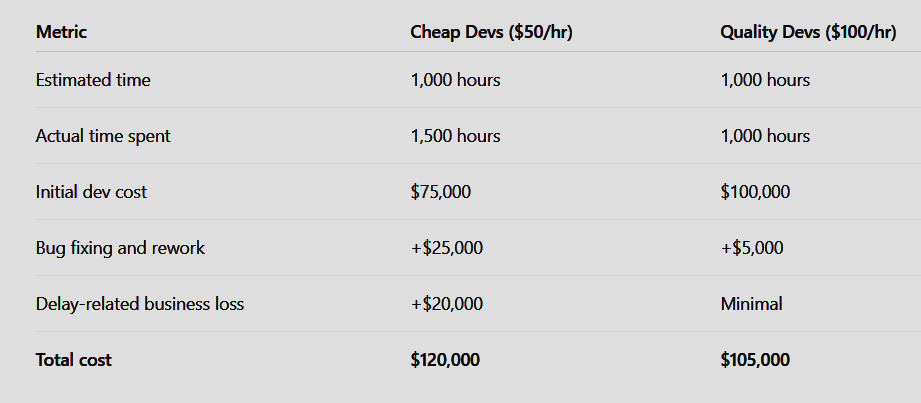As entrepreneurs, we’re constantly looking for ways to reduce costs, speed up delivery, and keep momentum high. It’s part of the job. But in the world of software development, there's one cost-saving strategy that repeatedly backfires: hiring cheap developers.
What looks like a budget-friendly decision today often turns into a financial and operational headache tomorrow — with spiraling costs, delays, and a demotivated team.This article breaks down why low-cost development is rarely the smart choice, based on real-world lessons from startup trenches. All figures and scenarios are anonymized (GDPR and friends are always watching) — but the implications are all too real.
The Appeal: Why Cheap Talent Looks Like a Smart Move
Let’s say you're comparing two dev offers: Developer A charges $50 per hour; Developer B charges $100 per hour
The feature list may appear identical, but it's important to recognize that developing technology involves far more than just writing code. Opting for a lower-cost solution to extend your runway may seem like a reasonable choice when purchasing office furniture, but it doesn’t hold true for software development. Software is not merely a collection of functions; it is a dynamic, evolving system. Starting with a flawed foundation can result in exponentially higher costs down the line.
Code Quality Is Not Optional — It’s Strategic
Here’s what quality software actually means:
- A robust, scalable architecture that won’t break when you grow
- Clean, maintainable code that future developers can understand
- Performance-aware choices that prevent slowdowns and crashes
- Documentation and testing, not just quick fixes
Experienced developers understand the business context behind their work. They think in terms of long-term value, maintainability, and team velocity. In contrast, inexperienced or underpaid developers often focus solely on closing tasks — doing “just enough” to make something run.
The result? A fragile system built on shortcuts, patched with workarounds, and riddled with debt — one that gets harder and harder to improve without breaking.
Technical Debt: The Quiet Killer of Momentum
Every shortcut in development — every rushed decision or unscalable hack — contributes to technical debt. And debt is manageable only if it’s recognized and controlled. Cheap developers rarely have the time, skill, or incentive to think architecturally. They optimize for speed, not sustainability. Unchecked technical debt leads to:
- Slower development cycles
- Increasing bug frequency
- Difficulty in onboarding new team members
- Rising maintenance costs
- The eventual need for a full rebuild
When ignored, tech debt compounds until the cost of fixing the system exceeds the cost of building it all over again.

The Snowball Effect: Slower Velocity, Lower Morale, Missed Markets
Messy codebases don't just affect development — they paralyze your entire product pipeline.
- Simple tasks start taking days
- Bugs take forever to reproduce
- Test suites break constantly
- New features stall due to unstable foundations
While your team is stuck firefighting issues, your competitors are releasing polished updates and steadily capturing your market share. And then there’s the human cost: developers hate working on bad code. It’s demoralizing, frustrating, and over time, it leads to burnout. Your best engineers may eventually leave, taking with them critical tribal knowledge that’s difficult to replace. And when new hires do come in, they often face a steep learning curve — taking months to get fully onboarded into a messy, unstable system.
You don’t just lose time — you lose momentum, talent, and trust.
The Hidden Cost of “Cheap”
At first glance, low hourly rates seem like a win. But here’s what’s often missing from the spreadsheet:
- Time spent fixing bugs
- The cost of lost feature velocity
- Support burden on other teams (QA, product, ops)
- Delayed go-to-market and missed revenue opportunities
- Reputational damage from buggy releases
When you tally up the full lifecycle cost of poor-quality development, you’re almost always worse off than if you had invested in senior, quality-focused engineers from day one.
A Real-World Comparison
Let’s take a simplified scenario. We’ve worked with clients who initially chose lower-cost developers — only to return later with projects that needed rescuing or rebuilding.

One client hired offshore developers at $30/hour. Six months in, they faced 220% budget overruns due to refactoring needs. After switching with DevPals to a senior team at $90/hour, feature delivery improved by 35%, and overall time to market was cut by 40%.
Not only is the "cheap" option more expensive — it also takes longer, delivers a worse product, and increases stress across the board.
What You Actually Get With High-Quality Developers?
- Strategic thinking: They build systems aligned with your business goals
- Future-proofing: Their code can evolve without crumbling
- Ownership: They care about outcomes, not just checklists
- Velocity: They may cost more per hour, but they deliver faster and cleaner
- Stability: They reduce churn, clarify complexity, and keep your team motivated
In short: they don’t just write code — they build products that last!
Final Thought: Quality Is an Investment, Not a Luxury
In the world of software, you get what you pay for. Saving money on development may feel good in the short term, but the long-term cost — in bugs, rebuilds, delays, and team frustration — can be devastating. If your goal is a scalable, stable, and successful product, then your first priority should be hiring the right people to build it.
Cheap code is expensive. Great code is leverage.
Thinking about outsourcing or building your team? Let’s talk about how quality-first development can save your business in the long run. Contact us!
